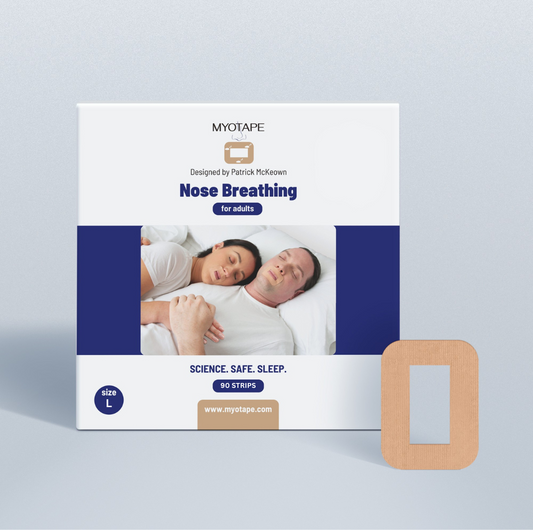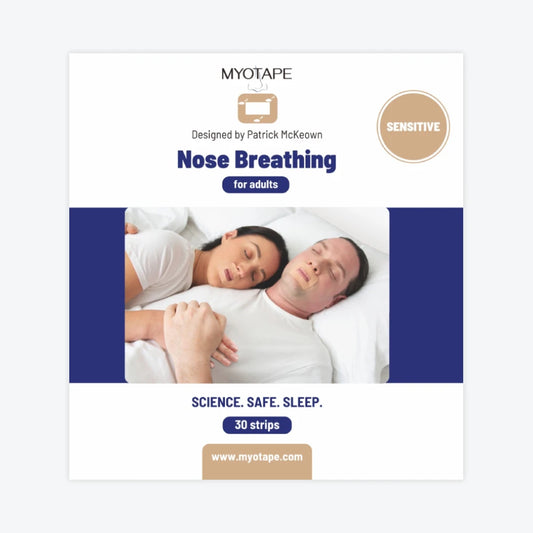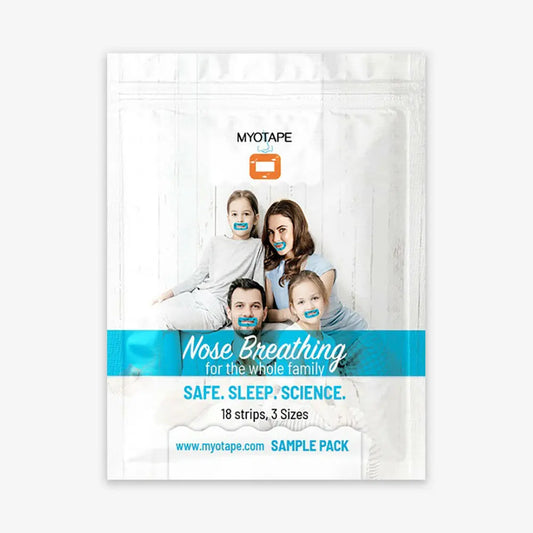Trying something new for your health can feel confusing, especially when there’s so much advice online. That’s why so many people are searching for simple solutions. And recently, mouth taping has become a popular trend.
You might have seen videos or tips suggesting you duct tape your mouth or use tape to keep your lips closed while you sleep, all in the hope of waking up refreshed, avoiding snoring, and a dry mouth.
But before you try taping your mouth shut, it’s essential to ask: is mouth taping dangerous? Could mouth taping actually be risky, especially for certain people?
This article is here to clear up the confusion. We’ll look at why mouth taping is gaining attention, what the real risks are, and who should be especially careful. If you’re hoping for better sleep, you deserve to know the facts to make the best choice for your health and safety.
What You Need to Know About Mouth Taping
Mouth taping involves placing a small piece of gentle medical tape across your lips before you sleep. The purpose is to keep your mouth closed, encouraging you to breathe through your nose at night.
Why do people try mouth taping?
The main reason is to promote nasal breathing, which is often considered healthier than mouth breathing. Mouth breathing has many negative health effects on the body compared to breathing through the nose. Here’s why nasal breathing is vital:
- Your nose filters and humidifies the air you breathe, protecting your lungs from dust, allergens, and germs.
- Nasal breathing helps your body absorb oxygen more efficiently and supports healthy blood flow.
- Breathing through the nose also produces nitric oxide, a molecule that benefits your cardiovascular and immune systems.
- Mouth taping can also be used together with CPAP to prevent air leaks and manage sleep apnea.
What does the research say about mouth taping?
A 2020 medical study stated that even people who normally breathe through their mouths (including children) can adjust to keeping their lips sealed for short periods, and most can comfortably breathe through their nose when prompted. You can check out other scientific research that has been done on mouth taping here.
How does mouth taping work?
- You apply a strip of medical or specially-designed tape to gently keep your lips closed.
- This encourages your body to rely on your nose for breathing during sleep.
- Many people use tapes explicitly made for this purpose, which are designed to be safe and easy to remove.
Potential benefits of mouth taping may include:
- Improved sleep quality
- A calmer breathing pattern, which may help with snoring and anxiety
- Less chance of waking up with a dry mouth and improved dental health
- Better support for your body’s natural defenses
As you can see, encouraging nasal breathing through mouth taping can help improve sleep quality and support your immune system, making it an appealing option for many.
However, for all its potential benefits, mouth taping raises important safety questions that deserve careful attention. Now let’s address most people's central concern: is it safe to tape your mouth while sleeping?
Many people are curious about mouth taping for better sleep, but the most important question remains: is it safe to tape your mouth while sleeping?
The answer isn’t a simple yes or no—it depends on several factors, including your overall health, the type of tape used, and whether you can breathe comfortably through your nose.

Safety Concerns and Risks to Consider Before Mouth Taping
While mouth taping is generally considered safe for many people, there are significant risks to be aware of before trying this technique:
- Breathing difficulties: If you have nasal congestion, a blocked nose, allergies, or a deviated septum, taping your mouth completely, could potentially restrict your breathing. Never tape your mouth if you can’t easily breathe through your nose, especially during cold and allergy seasons.
- Skin irritation: The adhesive can cause redness, itching, or rashes, particularly around the sensitive skin of your lips. Using high-quality, specially designed mouth tape can help reduce this risk. If you have a beard, you can learn about the guide for mouth taping with a beard.
- Adjustment period: Many people experience an initial adjustment phase where sleep may actually be disrupted as you get used to the sensation of having your lips secured.
- Psychological comfort: Some individuals, especially those with anxiety or claustrophobia, may find the feeling of restricted mouth movement uncomfortable or stressful.
There are some more detailed safety tips for mouth taping you can also read.
Are all mouth tapes safe to use?
Not all mouth tapes are designed with safety in mind. Many conventional tapes completely seal the mouth, which can be problematic due to a phenomenon called “mouth puffing.”
Mouth puffing occurs when a person instinctively tries to release air through their mouth during sleep, usually due to airway restriction. If the mouth is completely sealed, this natural mechanism is blocked, potentially causing discomfort or even worsening breathing issues.
Products specifically designed for mouth taping, like MyoTape, work differently by gently bringing the lips together without fully sealing the mouth. This allows for mouth puffing when necessary while still encouraging nasal breathing, making it a safer option for many people.
When mouth taping is not safe
Mouth taping can be dangerous for:
- People with sleep apnea (unless doctor-approved)
- Those with nasal blockages or breathing difficulties
- Individuals prone to nausea or vomiting
- Anyone who has consumed alcohol
- Children under four years old
- Those with anxiety or claustrophobia
- People with sensitive skin or adhesive allergies.
Can you use duct tape as mouth tape?
The answer is a definite no; you should never use duct tape instead of mouth tape on your mouth. Duct tape is not designed for skin contact and can cause serious irritation, allergic reactions, and is difficult to remove quickly in an emergency. Using duct tape on your mouth to stop snoring is dangerous and not recommended by any health professionals.
Who Should Be Especially Careful with Mouth Taping?

Mouth taping isn’t safe for everyone. While some people may benefit from it, certain groups face significantly higher risks and should either avoid mouth taping entirely or use it only with medical supervision.
Is mouth taping dangerous for kids?
Yes, mouth taping can be particularly dangerous for children. Their smaller airways are more vulnerable to obstruction and may not have the coordination or awareness to remove the tape if breathing becomes difficult.
Children under four years of age should never use mouth tape, and older children should only use products specifically designed for this purpose under close parental supervision. Find out whether mouth taping is safe your kid.
Is mouth taping for sleep apnea safe?
For people with sleep apnea, traditional mouth taping that completely seals the lips can be dangerous. This is largely due to something called “mouth puffing” - a natural response where your body needs to release air through your mouth during sleep, especially during breathing disruptions.
Products like MyoTape are designed with this safety concern in mind. Unlike conventional tapes that completely seal the mouth, MyoTape gently brings the lips together while still allowing for mouth puffing when needed. This makes it a potentially safer option for those with mild sleep apnea, though you should still get your doctor’s approval before trying any form of mouth taping if you have sleep apnea.
Is mouth taping safe for asthmatics?
Nasal breathing is crucial for children and adults with asthma, as it warms, filters, and humidifies the air before it reaches the lungs, helping to prevent airway narrowing and supporting lung health through nitric oxide production.
Mouth taping during sleep can be especially helpful for those who wake up with a dry mouth, as it encourages nasal breathing and reduces irritation caused by breathing in cold, dry air.
Research shows that combining mouth taping with the Buteyko Breathing Method can significantly benefit people with asthma, often leading to a 50% reduction in symptoms within two weeks. However, mouth taping should not be used during active asthma symptoms, by those with uncontrolled or severe asthma, or without consulting a healthcare professional.
If you have asthma and are interested in mouth taping, the safest approach is to:
- Learn the Buteyko breathing techniques
- Start by breathing through your nose during the day for a week
- Once you are comfortable breathing through your nose during the day, wear mouth tape during sleep
- You only need to wear mouth tape if you breathe through the mouth during sleep. You will know whether you are a mouth breather or have been mouth breathing during sleep if you wake up with a dry mouth.
Is mouth tape safe for pregnancy?
Pregnant women in their first trimester should not use mouth tapes, and afterward, they should consult with a medical professional before trying mouth taping. Pregnancy can cause nasal congestion, increased reflux, and breathing changes that might make mouth taping risky. Additionally, any sleep interventions during pregnancy should be discussed with a healthcare provider.
Is mouth taping safe for CPAP users?
When users of CPAP breathe through an open mouth during sleep, the tongue is in the lower resting position, and the lower jaw falls downwards. This narrows the airways, resulting in increased pressure to help open them and ensure a steady flow of breathing during sleep.
In addition, people who commonly mouth breathe during sleep are likely to be prescribed a full face mask. This increases the risk of leakage and is not as comfortable as wearing a nasal mask. Breathing through the mouth while wearing the CPAP has been shown to reduce adherence. Switching to nasal breathing by learning the Buteyko technique and wearing mouth tape. CPAP users can use mouth tape in combination.
However, CPAP users should talk to a medical professional before using them together. While preventing mouth leaks is important for CPAP effectiveness, specially designed chin straps are also good alternatives to mouth taping for CPAP users. Combining mouth taping with CPAP without medical supervision could interfere with the therapy’s effectiveness.
Side Effects and Safety: What to Know About Mouth Taping
Mouth taping can support better sleep and nasal breathing, but it’s important to be aware of potential side effects and how to avoid them. Here are some potential side effects of mouth taping and what to keep in mind:
- Mild skin irritation or redness may occur, especially for sensitive skin. However, MyoTape’s hypoallergenic, gentle adhesive helps minimize this risk.
- Breathing discomfort can happen if your nose becomes congested. Unlike other mouth tapes, MyoTape’s design allows for emergency mouth opening and “mouth puffing,” so you can breathe easily if needed.
- Anxiety or claustrophobia is possible for some, especially at first. MyoTape doesn’t fully seal the lips, making it easier to adapt and less likely to cause discomfort.
- Adjustment period: It’s normal for sleep to feel different as you get used to mouth taping.
Although mouth taping can be risky in certain situations, such as if you have nasal congestion, sleep apnea, or are prone to nausea or vomiting, it can also delay emergency response if quick mouth access is needed. That’s why it’s essential to consult your doctor before trying mouth taping and always to use a safe, medically-designed tape like MyoTape to minimize potential dangers.
How to Practice Mouth Taping Safely
Safety should be your priority if you’re interested in mouth taping. Only use products specifically designed for mouth taping, such as MyoTape or medical-grade micropore surgical tape, never use household tape or duct tape, which can cause skin damage and are difficult to remove in emergencies.
Start slowly with short 20-minute practice sessions before attempting a full night. Test your nasal breathing capacity first by sitting quietly and breathing through your nose for three minutes. If this is difficult, work on improving your nasal breathing before trying overnight mouth taping.
Keep a corner of the tape loose for quick removal if needed, and remove it immediately if you experience any discomfort. You will start to see signs that mouth taping is working for you when you use it safely.
For the best results, consult with a medical professional before starting, especially if you have underlying health conditions.
Why MyoTape Is Your Safest Choice
When it comes to mouth taping, safety cannot be compromised. MyoTape, designed by breathing expert Patrick McKeown, protects you where other tapes fail. Its unique design allows for emergency mouth opening and natural “mouth puffing” while still training your lips to stay closed during sleep.
Don’t risk your health with regular tape. MyoTape’s hypoallergenic adhesive prevents skin irritation, while its easy-removal design ensures quick access to your mouth when needed. This thoughtful engineering makes it suitable even for those with sensitive skin or claustrophobia concerns.
Protect yourself while transforming your sleep. You can check out our range of effective mouth taping products designed for everyone, including mouth tape for kids, adults, those with sensitive skin, and even those with facial hair.








